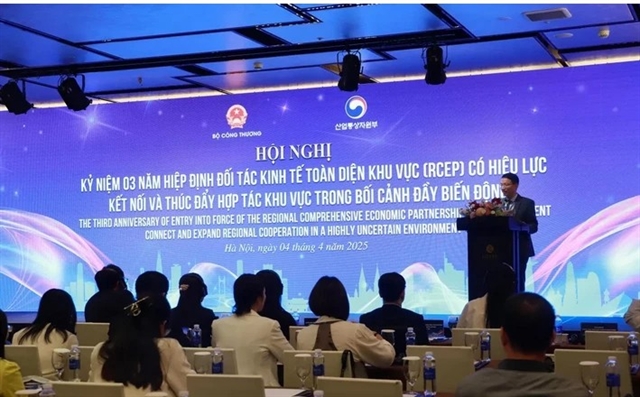Currently, the agreement covers a market of approximately 2.3 billion people, representing around 30 per cent of the global population and GDP. Notably, five of its 15 members are members of the G20.

HÀ NỘI — The Ministry of Industry and Trade of Vietnam (MoIT) and the Ministry of Trade, Industry and Energy of the Republic of Korea (RoK) jointly held a conference in Hà Nội on Friday to commemorate the third anniversary of the Regional Comprehensive Economic Partnership (RCEP) Agreement’s entry into force.
Themed “Connecting and Expanding Regional Cooperation in a Highly Uncertain Environment,” the event provided a platform to review three years of RCEP implementation, assess its impact on businesses, and propose solutions to trade barriers.
Key discussions at the conference centered on improving customs procedures to enhance trade, introducing frameworks for sustainable trade cooperation, and addressing both the opportunities and challenges arising from RCEP enforcement.
Speaking at the event, Director of the MoIT’s Department of Multilateral Trade Policy Lê Triệu Dũng highlighted RCEP as the world’s largest free trade agreement by population and GDP.
Signed in November 2020 by 10 ASEAN countries and five partners - China, Japan, the RoK, Australia, and New Zealand, the agreement came into effect on January 1, 2022, for six ASEAN members and four partners. It later entered into force for the RoK in February 2022, Malaysia in March 2022, Indonesia in January 2023, and most recently, the Philippines in June 2023.
The Vietnamese official highlighted that RCEP, following eight years of negotiations, came into effect in 2022. Over the past three years, it has emerged as a significant driver of export growth, trade expansion, investment facilitation, and regional supply chain development, contributing notably to global economic recovery and resilience.
Currently, the RCEP encompasses a market of approximately 2.3 billion people, accounting for around 30 percent of the global population and GDP. Among its 15 members, five are also members of the G20.
The agreement’s open-access framework has attracted interest from new economies seeking membership. Member countries have finalized accession procedures and established an RCEP Support Unit (RSU) to strengthen implementation efforts, underscoring the growing strategic importance of the partnership.
Dũng said that over the past three years, the RCEP has positively impacted Việt Nam’s international economic integration and supported the broader economic and trade activities of ASEAN and participating countries. By providing a unified legal framework, the agreement enhances regional transparency and cements ASEAN’s role as an attractive investment destination, especially critical amid current global trade uncertainties.
He also emphasised the vital role of the RCEP in bolstering Việt Nam–RoK economic relations. Since 2022, Việt Nam has consistently ranked as the RoK’s third-largest trading partner. Both countries aim to raise bilateral trade to US$100 billion in 2025 and $150 billion by 2030 in a balanced, sustainable manner.
Jinhyeok Choi, Director General of the FTA Policy Bureau of the Korean Ministry of Trade, Industry and Energy, underscored the RCEP’s value in enhancing not only the RoK–Việt Nam ties but also regional trade cooperation as a whole. — VNS





